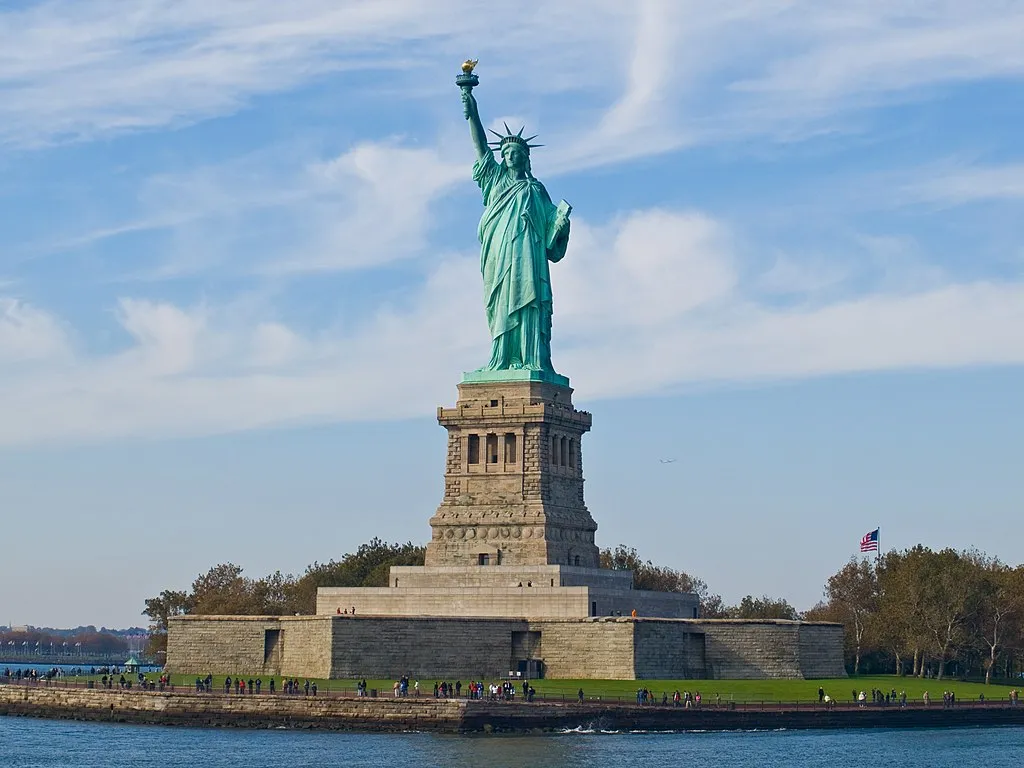The Statue of Liberty is famous for its green color, but it wasn’t always that way. When it was first built, it was a shiny copper color. Over time, the copper reacted with the air and turned green. This green color is called a patina, and it’s caused by a chemical reaction between the copper and oxygen in the air. The patina protects the copper from rusting, so it’s actually a good thing. In fact, the green color of the Statue of Liberty is one of the things that makes it so iconic.
The Statue of Liberty Before Green
You know that famous green lady standing tall in New York Harbor? The one and only Statue of Liberty? Well, she hasn’t always rocked that emerald dress. Believe it or not, when she first arrived on the scene back in 1886, Lady Liberty was a radiant copper goddess! She literally gleamed under the sun.
But then Mother Nature stepped in with a little something called oxidation. It’s a fancy way of saying that oxygen and copper got together and decided to give the statue a makeover. Slowly but surely, a green film called patina began to form on her copper skin.
Now, this patina wasn’t just a fashion statement. Think of it as a magical shield. It actually protected the copper underneath from rusting and falling apart. As the years went by, this green cloak just got thicker and more noticeable, eventually giving the Statue of Liberty that iconic green look we all know and love.
Here’s a quick timeline of Lady Liberty’s color transformation:
| Year | Color |
|---|---|
| 1886 | Shiny Copper |
| Early 1900s | Green patina begins to appear |
| Around 1930 | Distinct Green color is well established |
So, the next time you see a picture of the Statue of Liberty, remember her vibrant copper beginnings. It’s a good reminder that even the most iconic landmarks are shaped by the forces of nature and time!
Have you ever wondered about creepy facts about the Statue of Liberty? Did you know that there was a time when experts didn’t think the Statue of Liberty would turn green? Or that the Statue of Liberty is worth more than you might think?
What caused Statue of Liberty to change color?
Picture the Statue of Liberty, and you probably see its famous green glow. But she hasn’t always rocked that look! When she first arrived in New York Harbor back in the late 1800s, Lady Liberty was a shiny copper color, much like a brand new penny. You see, her outer layer is made entirely of copper sheets, and copper, when exposed to the elements, well, it has a bit of a makeover moment.
The culprit behind this transformation? A chemical reaction! Think of it like this: the copper on the Statue of Liberty got thirsty for oxygen and moisture hanging out in the air. As they mixed and mingled on the statue’s surface, they created a new substance called copper carbonate, also known as patina. This patina is a greenish-blue hue, and it’s what gives the Statue of Liberty its unique color today.
But wait, there’s more to the story! The specific environment around the statue played a big role too. See, being right there by the ocean, salty sea air was a constant companion. That salt got in on the action, reacting with the copper to form a special kind of patina – salt patina. This salt patina is a bit different from regular patina and contributes to the Statue of Liberty’s specific shade of green.
So, there you have it – the Statue of Liberty’s color change is a natural phenomenon, a slow and beautiful transformation thanks to the magic of chemistry and a touch of salty air.
Why is Statue of Liberty not original color?
We’ve already talked about how the Statue of Liberty’s color changed, but let’s dive into the why a bit more. Think of it like this: have you ever seen an old penny turn dull brown or even greenish? It’s the same idea with Lady Liberty! That shiny, penny-like copper she was made of wasn’t meant to stay that way forever.
The Statue of Liberty is covered in hundreds of thin copper sheets, almost like a giant, incredibly detailed puzzle. Over time, the air and water, especially the salty sea air around New York Harbor, reacted with the copper. This created a new layer on the surface called a “patina.” It’s basically copper rust, but instead of being a flaky, damaging rust, it’s actually pretty tough! This greenish-blue patina is what gives the Statue of Liberty her now-famous look. It’s like the statue grew its own protective coat over time.
Think of it like this: the patina is like the Statue of Liberty’s own shield, protecting the copper underneath from further damage. So while she might not be that bright copper color anymore, the green patina is a sign of her age, her resilience, and how well she’s stood up to the elements for over a century!
How Long Did It Take the Statue of Liberty to Turn Green?
We all know Lady Liberty wasn’t always green. She started as a shiny, copper beacon of hope, but that iconic green hue is a tale of chemistry and time.
See, the Statue of Liberty is covered in thin copper sheets. Copper, when exposed to air and water, undergoes a process called oxidation. It’s like rust, but instead of crumbling, it forms a protective layer. This layer, the patina, is what gives the Statue of Liberty its green color.
Now, you’re probably thinking, “How long did that take?” Well, it wasn’t an overnight makeover. It took around 30 years for the Statue of Liberty to fully embrace its green coat. Imagine the whispers in the early 1900s as the change slowly happened!
This wasn’t just a cosmetic change. The patina is like a shield, guarding the copper from further damage. It’s the reason the statue has stood strong against the elements for over a century. So, the next time you see a picture of Lady Liberty, remember, that green isn’t just a color, it’s a symbol of time, resilience, and a bit of chemistry magic!
FAQ
Q1: What was the original color of the Statue of Liberty?
A1: When it was constructed in the late 1800s, the Statue of Liberty was a dull brown color due to its copper exterior.
Q2: How long did it take for the statue to turn green?
A2: The process of oxidation, which caused the statue to turn green, began as early as 1906 but took several decades to fully develop. By 1920, the statue had completely turned green.
Q3: Why did the statue turn green?
A3: The copper exterior of the statue reacted with oxygen and moisture in the air, forming a green patina or verdigris. This patina is a protective layer that helps prevent the copper from corroding.
Q4: Was there any debate about the green color?
A4: Initially, some people wanted to paint over the green patina, as it was not the intended color of the statue. However, the patina was eventually accepted as the iconic symbol of the Statue of Liberty.
Q5: What is the scientific term for the green color?
A5: The green color of the Statue of Liberty is scientifically referred to as verdigris. It is a type of patina that forms on copper when it is exposed to the elements.
- 1 Liter to Fluid Ounces: Easy Conversion Guide - April 9, 2025
- Unlock what is the seventh month: A Cross-Cultural Calendar Guide - April 9, 2025
- Discover White Fruits: Ultimate Guide to Taste & Nutrition - April 8, 2025

















Comments are closed.